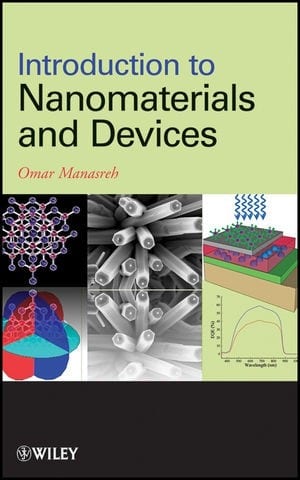Introduction to Nanomaterials and Devices
Omar Manasreh
Hardcover
488 page
US $110.00
Reviewed by Professor Kourosh Kalantar-zadeh, Associate Professor, RMIT University
The book by Professor Omar Manasreh was a great surprise for me. For years, I had been trying to find a reference that could be used as a reliable textbook for students in the field of nanoelectronics. For providing students with such a reference, I personally had struggled since 2006, gathering bits and pieces of relevant knowledge and putting them together as a coherent text. In time, I realized that this was not a trivial task, as the learning materials needed to encompass the fundamentals of semiconductor physics, quantum mechanics, electronics, optics and materials sciences. I have to admit that I had a hard time at the beginning as I needed to educate myself about different aspects of these fields. My collection was eventually taking shape and I was ultimately feeling confident about the text that I had prepared when I saw the book by Professor Manasreh. It was unexpected for me to that this book had all my gathered materials, plus much more, in one nice comprehensive collection. Seeing the content, the flow and depth of the materials, I finally gave up and decided to use this book in my future courses about nanoelectronics.
Studying Professor Manasreh’s background in research and teaching activities, I realized that he has already published a large number of academic books and book series in the field of electronics. He is very familiar with the optical properties of nanomaterials and has a large number of publications in the field of III-V semiconductors. Having this knowledge and the capability in writing that he has nurtured over years, this book appears as the culmination of Professor Manasreh’s capability in creating great references in the field of low dimensional electronics. After reading the book, I am certainly feel confident in recommending this book to my students.
The book consists of seven chapters: the first one describes different methods of nanomaterial synthesis – probably this is the only part of the book which is not as strong and coherent as other sections as it misses some of the most recent nanofabrication techniques. All other chapters from here flow smoothly. The applications of quantum mechanics are very well written and intelligently guide the readers to the final destination that is the application of equations in semiconducting materials. A whole chapter is allocated to density of states in different low dimensional structures. I was pleased to see very accurate description of different statistics in this chapter. The next chapter is focused on the optical properties of nanomaterials. Some of the most important issues which are frequently faced in describing the optical properties of nanodimensional materials are presented. I was happy to see a strong chapter on the charge transport in nanodimentional materials in the next chapter: different causes of carrier charge scattering and their insets. Chapter six is a fantastic collection of different nanosize devices and how quantum mechanical properties affect their operation. Finally the book finishes with one whole chapter on optoelectric devices. I would also like to express my appreciation of the appendices. The description of Heisenberg Uncertainty principle, perturbation, Angular momentum, WKB approximation, Lattice vibration and tunnelling are quite handy.
The book figures are attractive. It seems that the author has spent long hours personally creating and editing them. Knowing how long it takes to compose one of these images I appreciate the time that has spent on them.
The examples are quite useful and timely. Problems presented at the end of each chapter are relevant to the content. I just wish that the answers to them were presented somewhere. This could have made the book extremely attractive for lecturers and those who would use this book for self-education.
Altogether “Introduction to nanomaterials and devices” is an attractive and professional book and I highly recommend this book to any lecturers and academics who intends to present a high quality course in the field of nanoelectronics to students.

















